Every September 2nd, the feast day of Aghios Mamas, protector of animals, the locals on Hydra walk up a hill in the island’s interior to a small church dedicated to that holy man, to have their livestock blessed. This year, we join them, setting off at 6:45 in the morning from the port on a boat that takes us to Plakes Vlychou. From there, we head off on foot in the company of Stelios Bakratsas, who regularly walks the trails of Hydra. The uphill stretches are gentle, the sun is warm but not hot, and the ground is covered with low vegetation. Every so often we see a local riding a horse or a mule. They ask us if we’d like to take a load off by allowing them to carry our bags. “We’re fine, thank you”, we respond, and they nod and move on ahead.
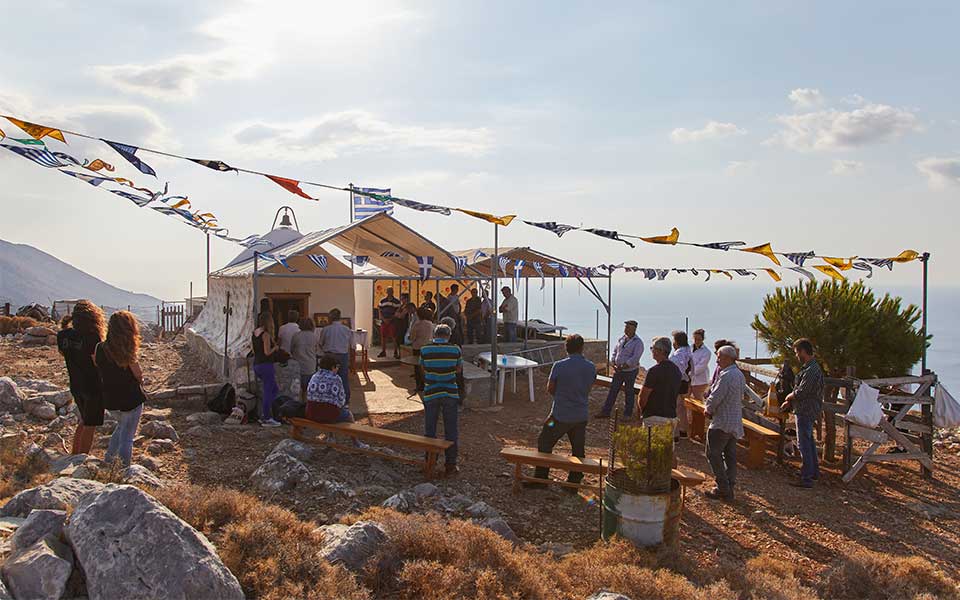
© Dimitris Vlaikos
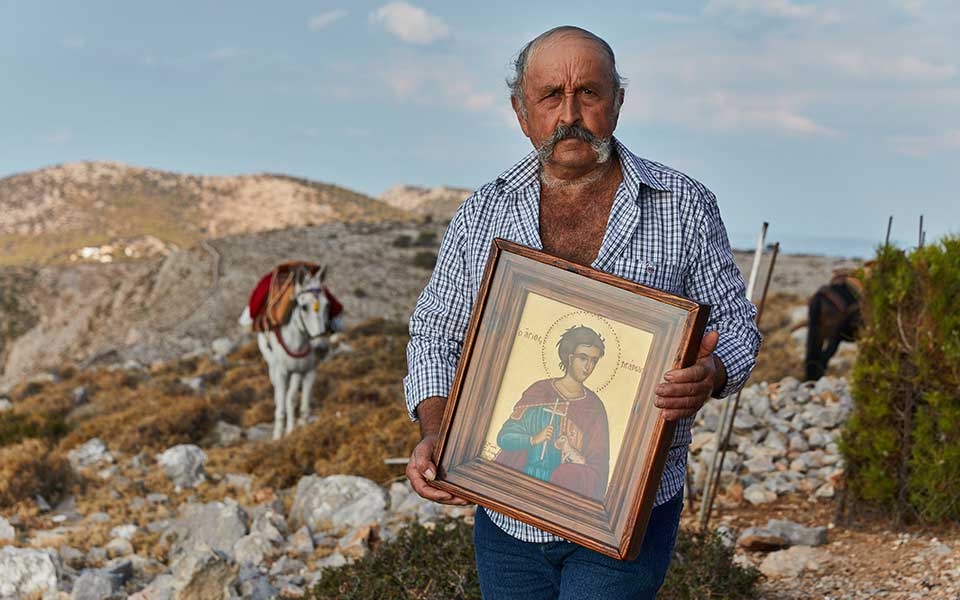
© Dimitris Vlaikos
At five minutes to nine, after about an hour and a half of walking at a leisurely pace (2.8km/330 m elevation gain), we reach the Chapel of Aghios Mamas, built in a prominent spot with a view of Mt Eros (588m). There aren’t many people there, perhaps three dozen. They attend the service and follow the litany of the icons around the chapel, accompanied by a cacophony of neighing and church bells. When it’s time for the blessing, the animals pass, one by one, in front of the priest, who sprinkles them with holy water, while their owners feed them blessed bread – leftovers from the same loaves that are cut for the offering. As is often the case on these occasions, this service is followed by a beer, a glass of mastiha liqueur and some delicious local roast goat. By half past ten, we’ve already enjoyed a boat ride, a hike, a blessing, and a meal.
Hydra is considered by many to be the island of art in Greece; it boasts several exhibition spaces and has a fanatical following among artists, many of whom are regular visitors. Without attending the gallery exhibits or visiting the island’s museums, however, one can still find art here, as we have, watching the locals walking their animals up the hill to be blessed, seeing dogs dashing about under the table that bears the holy water and disturbing the solemn service, and hearing the priest end the ceremony with his hope that “the Saint protect our lives and our animals.” In artistic terms, we could describe what we have witnessed as a powerful and authentic piece of performance art.
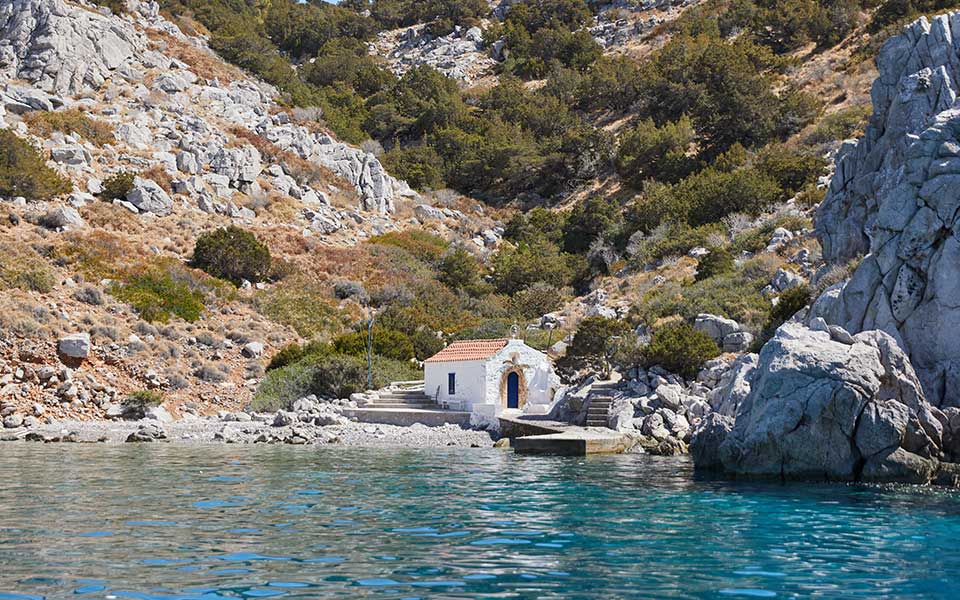
© Dimitris Vlaikos
Hugging the coast in a wooden boat
Whether on land or at sea, it seems you can’t escape art on Hydra. Even if you try, it will appear in front of you, uninvited. We arrange to go on a boat ride with Yiannis Tsanos, who organizes day trips and fishing excursions around Hydra. He has a 9.8-meter traditional wooden boat which we share with a sizeable group of filmmakers, writers, and artists. Among them is Dimitris Antonitsis, who has been organizing the Hydra School Projects exhibition for the past 22 years. You’d expect the conversation among this artistic crew would focus on art, but instead it turns to life.
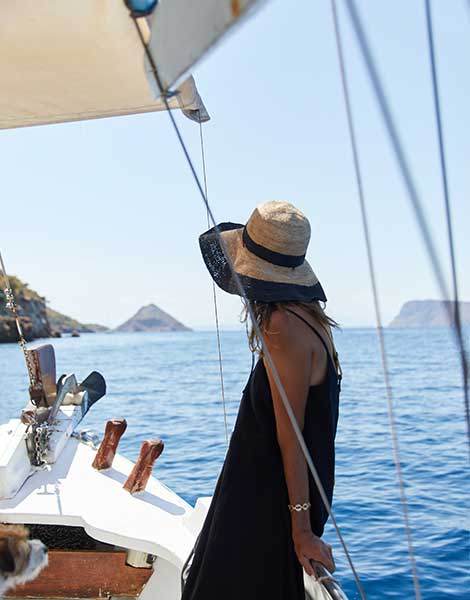
© Dimitris Vlaikos
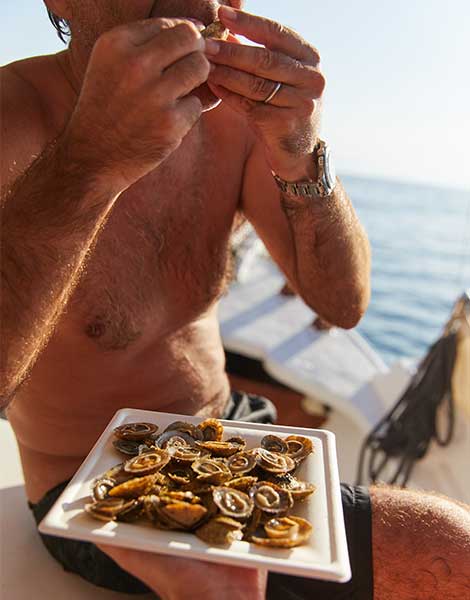
© Dimitris Vlaikos
Yiannis is hospitable and knows how to create a warm atmosphere, while three dogs who have come along with us dive into the water first, setting the mood for a vacation feeling. The whole thing turns into a very pleasant boat ride along the north coast of the island. We pass the islet of Kivotos and then Aghios Kyprianos Beach, with its white chapel and emerald waters, before threading the narrow passage between Hydra and the island of Dokos (the location of one the world’s oldest shipwrecks). Along the way, we hear various interesting place names, such as Bisti Beach (“Bisti” means “tail” in arvanitika, a form of Albanian spoken in Greece), before reaching the southeastern point of the island and the islets of Tagari and Disaki, known by some locals as Dyo Adelfia (“Two Brothers”). We stay here for several hours, taking our first September dives for limpets and sea urchins, which we eat raw on the boat, seasoned only with sea water. This is how you pass the time on an artistic boat ride in Hydra with real, authentic artists who how to have a good time, and who could give lessons in how to welcome autumn gracefully.
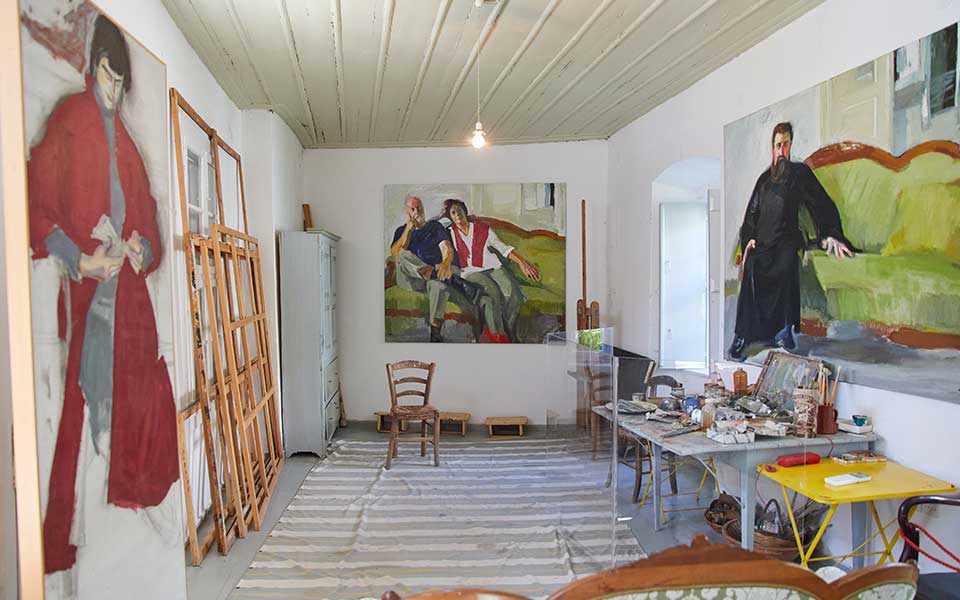
© Dimitris Vlaikos
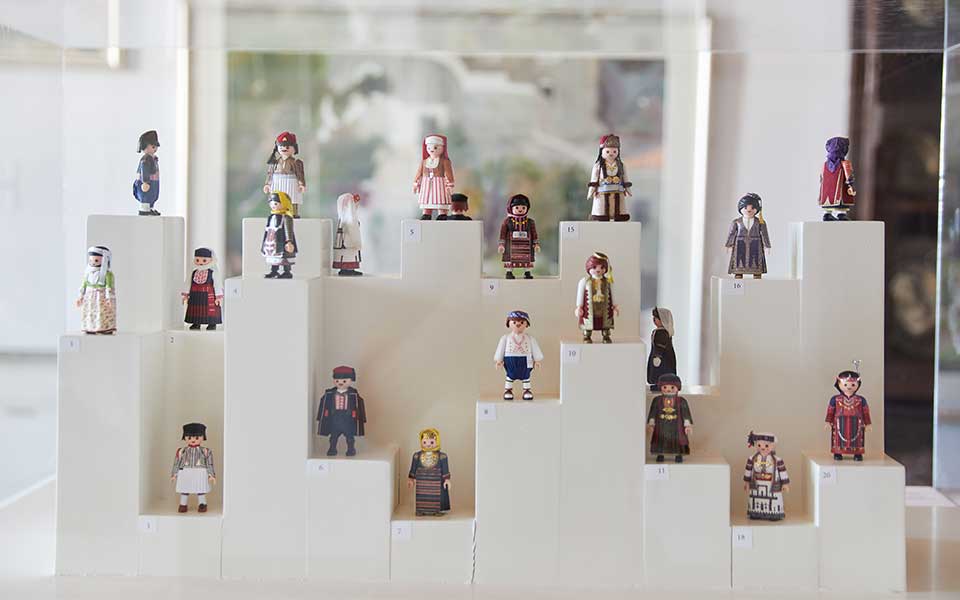
© Dimitris Vlaikos
Art inside and out
You may find art everywhere around you, but it’s worth exploring the formal art venues of Hydra – its museums and exhibition spaces – as well. The first thing one notices when browsing the exhibition map is that it contains an amazing variety. From the bright atelier of the late modernist painter Panayiotis Tetsis, a native of Hydra, to the historic Lazaros Kountouriotis House. When we visited the latter, there was an exhibition of Playmobil figures in traditional costume presented next to original costumes. We also caught an exhibition of painted works by folk artist Theofilos at the Hydra Historical Museum and Archive, an exhibit in the beautiful Municipal Market, one at the Old Slaughterhouse.
There’s no shortage of exhibits and museums on Hydra. But equally interesting are the landmarks of the islands and the architectural features in its buildings, both of which we get to know with the help of Maria Voulgari, who takes us on a historical walking tour of the port and town. We start at the benches in front of the Fine Arts School, at the spot where they once built ships at the time of the Revolution. She directs our gaze back towards the traditional settlement, untroubled by the sound of engines or exhausts. Hydra is an island free of cars and motorbikes, of traffic sounds or strong light pollution – it breathes clean air and helps its visitors detox from big city problems.
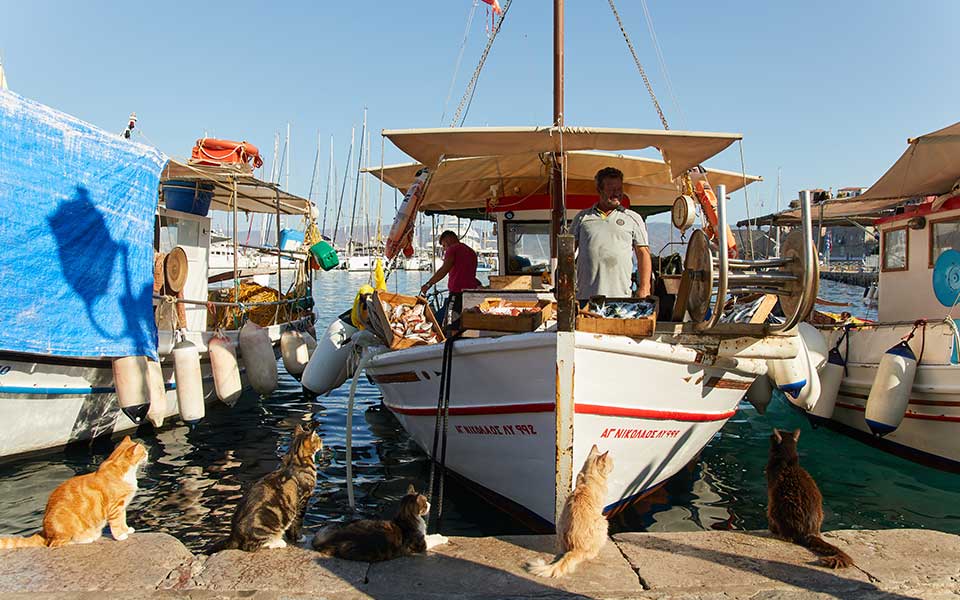
© Dimitris Vlaikos
Starting our walk, we pass the statue of Antonis Economou, a Hydra sea captain and major figure of the Greek Revolution, as well as a monument to the great sea captain Miaoulis, and then spot the mansion of Pavlos Kountouriotis. The Sophia Loren Windmill (named after the female lead in “The Boy and the Dolphin” filmed here in 1957) is next. We also observe the revolutionary flag of Hydra, featuring a cross, an anchor and a snake, which flies on many of the boats in the harbor.
In the Cathedral dedicated to the Dormition of the Virgin, we note the historic, if somewhat unusual, icon of the Virgin of the Sea Battles, which shows Christ holding a baby, which is interpreted either as the Virgin as an infant or a representation of her spirit. Hydra is one vast museum, a very beguiling island with its own way of winning you over. On the one hand, it seems untouched by time, but on the other hand it’s a lively place, both quaintly old-fashioned and vibrantly modern, elitist yet accommodating, and small but also large, so that the three days we’re spending here seem far too few, especially as the time to leave approaches.
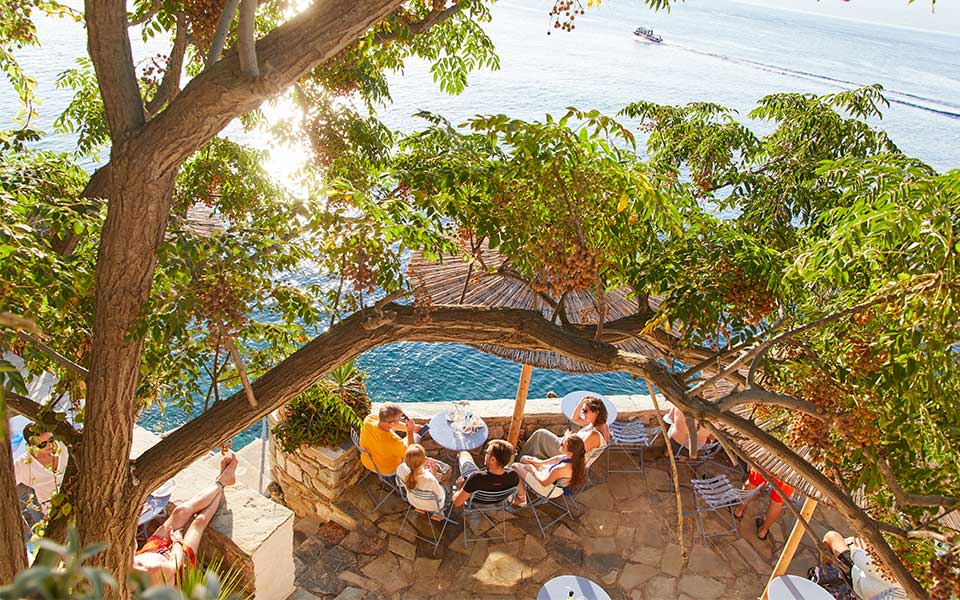
© Dimitris Vlaikos
Inspirational Hydra
It is well known that Leonard Cohen had a decades-long relationship with Hydra and owned a home here. What not everyone knows is that Cohen wrote “Bird on a Wire” on Hydra in the 1960s, inspired by the birds sitting on the island’s first telephone wires. For Hydra, this was progress, but for Cohen it was a sign that he could not escape the webs of civilization, even on this pristine little Greek island.
Another lover of Hydra is David Gilmour, singer and guitarist with Pink Floyd. After five years of artistic silence, Gilmour released the song “Yes, I Have Ghosts” in 2020, with a video clip shot on Hydra. Gilmour’s song complemented the 2020 book “A Theater for Dreamers” authored by the journalist and writer Polly Samson, who is his wife. The story, which is based on real events, is set on Hydra in 1960, and explores the lives of a bohemian circle of poets, painters and musicians. The book, which made the Sunday Times Bestsellers List, is available for sale on the island.
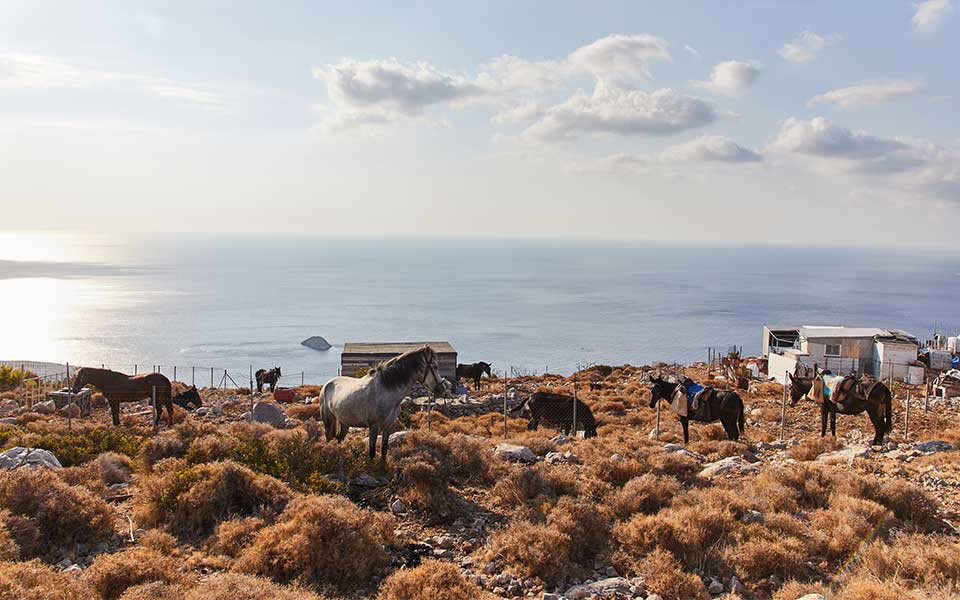
© Dimitris Vlaikos
The equine world
Hydra is a peculiar place. As all motorized traffic has been banned, the island depends on pack animals – mainly horses and mules – to transport people and goods. The island has found itself in the eye of the storm recently, with social media reports accusing the locals of mistreating their animals. The locals say they consider their animals as members of the family, and that it wouldn’t be in their interest to treat them badly, as they depend on them for their livelihoods. Visitors are encouraged to ask the muleteers as to how they handle their animals, how many hours they work them and under what conditions, how much they weigh and what weights they carry, whether they are kept tied up, and so forth. The more people get involved, the more transparency we will have regarding the animals’ living conditions. For more information, you can visit the site fonitisydras.com, where you can read up on the subject.












